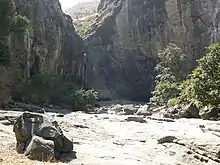Banoti waterfall is a remote and desolate location off the village of Banoti in the Soegaon taluka of the Aurangabad district in the Maharashtra state of India. This waterfall is least known in spite of being quite picturesque and enchanting. Access to the place is difficult without involving a long trek from the nearest village of Banoti.
The importance of the waterfall is linked to archaeology and Buddhism, since there is an ancient Buddhist monastery of the fifth century CE. The monastery (or its remains) is not accessible (except with the help of a climbing rope). The existence of such an ancient monastery adjacent to the Banoti waterfall is largely unknown to the modern world except for some references in archaeological works.[1] It was, indeed, this waterfall that cradled the ancient Buddhist monastery of Banoti, which was contemporary to the Ajanta cave temples.
The waterfall, however, is not large, its optical width being nearly 20 ft and elevation nearly 200 ft. It is a seasonal waterfall that runs during monsoon season.
Facts
| Country | India |
| State | Maharashtra |
| District | Aurangabad |
| Taluka | Soegaon |
| Coordinates | 20.4430900° N, 075.3124130° E (20.443090, 075.312413) |
| Type | Plunge |
| Elevation | Approximately 200 ft (60 m) |
| Number of drops | 1 |
| Width | Approximately 20 ft (6 m) |
| Watercourse | Seasonal |

Relative location and approach
- Nearest habitation or human settlement: Banoti village (nearly 20 km trek)
- Nearest possible camp: Fardapur (via Soegaon: 48 km)
- Nearest district headquarters/ city: Jalgaon and Aurangabad
- Nearest serviced airport: Aurangabad, Maharashtra (148 km)
Other location and approach
- Amruteshwar (Lord shiva) temple via banoti chaufuli 1 km.
- Lord shanidev temple via banoti chaufuli 1 km.
- Lord ganesha temple MSEB, Banoti.
- Naygaon ford Via banoti- Naygaon 4 km.
Major rail heads
- Jalgaon, Maharashtra (108 km via Fardapur; 73 km via Pachora)
- Bhusawal (97 km via Pachora and Jalgaon; 105 km via Fardapur and Jamner)
- Aurangabad (116 km via Kannad)
- Pachora (19 km via Gondegaon)
- Chalisgaon (43 km via Nagad)
References
- ↑ The Banoti rock-cut cave temples are mentioned in the following publications: Spink, Walter M. Ajanta: The end of the Golden Age. Vol. 1. Brill, 2005; Cohen, Richard S. "Nāga, Yakṣiṇī, Buddha: Local Deities and Local Buddhism at Ajanta." History of Religions (1998): 360-400 (395); Singh, Rajesh Kumar. "The Early Development of the Cave 26-Complex at Ajanta." South Asian Studies 28, no. 1 (2012): 37-68 (63); Brancaccio, Pia. The Buddhist Caves at Aurangabad: Transformations in Art and Religion. Brill 2010, p. 91.